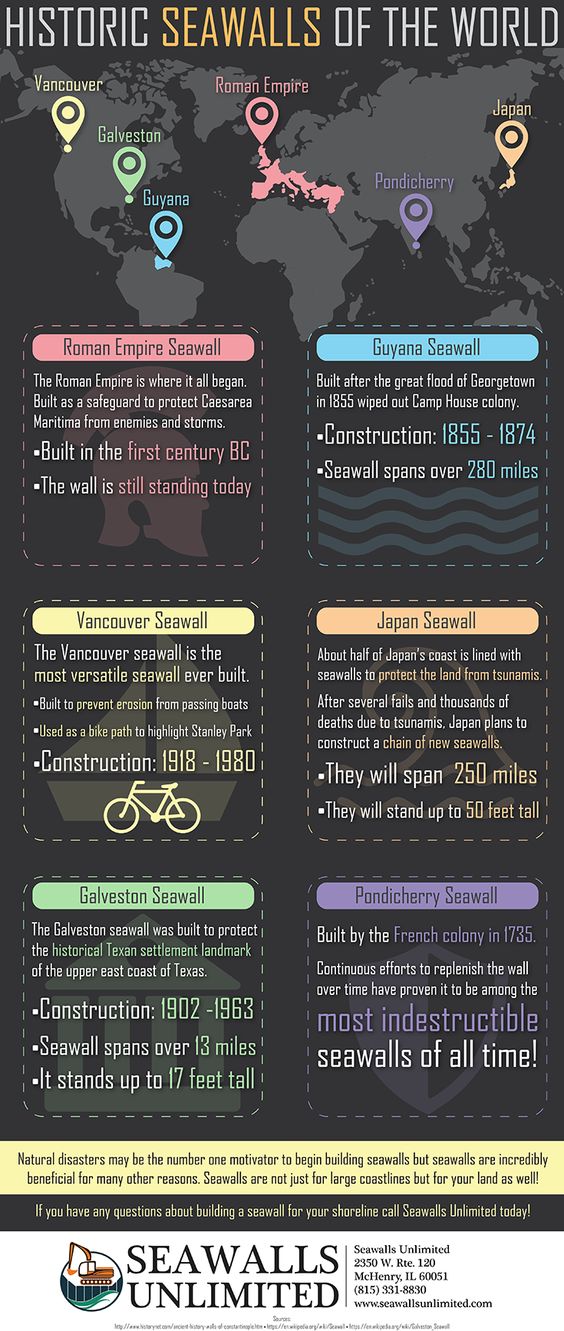The history surrounding seawalls is vast and dates back thousands of years to the Roman Empire and the first century BC. The breakwater wall was built as a safeguard to protect Caesarea Maritima, not only from harsh weather conditions, but also to keep out enemies. This wall is still standing today.
Over time, the construction of seawalls changed and became more complex as new and better materials became available. Whether the walls were built to fight off the storm of soldiers or just storms, seawalls have proven to be an extremely valuable construct for many empires and cities across the globe.
Pondicherry Seawall
The great seawall of Pondicherry, reaching 27 feet above sea level, still lies on the coast of India. The stone wall’s construction was completed in 1735 back when the city was still run by a French colony. The barrier has been actively maintained and replenished with boulders by the residents and the government for 300 years.
When the Indian Ocean earthquake and tsunami struck stormed the south-eastern coastline of India in 2004, thousands were killed but the territory of Pondicherry was left untouched. Even after three centuries the barrier did not fall. This is due to the hard work of maintaining the cities valuable structure.
Galveston Seawall
Galveston Bay, located in the upper coast of Texas, is connected to the Gulf of Mexico and is one of the largest bays in the United States. Galveston Island is iconic to Texas as it was the home of the coastal Texas’ first settlement. Later it became essential during the oil boom as the main Texas oil shipping center.
In fear of hurricanes the city began construction on the seawall in 1902. Initially completed in 1904 and extending only 3.3 miles, they decided to continue their efforts to keep their historic land secure. By 1963 they had successfully extended the length of the wall to over 10 miles long and 17 feet tall.

Vancouver Seawall
The Vancouver seawall lies along the coast of Stanley Park. The idea for this wall was not conceived after the destruction from a tsunami like most others. The argument proposed in 1917 to the government was that the waves produced by passing boats were causing significant land erosion along the coast. As a result the government agreed to partially fund the construction of the seawall which was fully completed by 1980.
The city of Vancouver uses the seawall in a very unique way. This wall is not only perfectly capable of keeping the land dry and safe from erosion but it is also used as a tourist attraction and stands as a functional park for joggers and bicyclists.
Guyana Seawall
After the great flood of February 1855 besieged the region of Georgetown and wiped out the Camp House colony, the erection of the seawall began. Work on the seawall began immediately and the construction of the first section was completed by 1860. However, driven by fear and dedication to keep their home safe, the people of Guyana continued building the wall until 1874 when the wall reached 280 miles.
Japan Seawall
Seawalls already cover the border of almost half of Japan’s coastlines to help protect the land from destructive tsunamis. Unfortunately, due to the enormous tsunami’s that usually strike Japan, many of the seawalls fail. The largest seawall in the world which cost Japan $1.5 billion was not capable of fighting off the strong waves of the 2011 tsunami that killed nearly 20,000 people and lead to Japan’s nuclear disaster.
Thankfully, Japan is currently plotting its newest tactic to combat nature’s future disasters. They plan to build a 250 miles chain of seawalls costing $6.8 billion and reaching a height of 5 stories.
Natural disasters may be the number one motivator to begin building seawalls but they are incredibly beneficial for many other reasons. Seawalls are not just for large coastlines but for your land as well! Just imagine your beautiful shoreline and land deteriorating over-time and before you know it all of that land has disappeared along with the value of your property.
If you have any questions about building a seawall for your home or business, please call Seawalls Unlimited today!
Seawalls Unlimited
2350 W. Rte. 120
McHenry, IL 60051
(815) 331-8830
